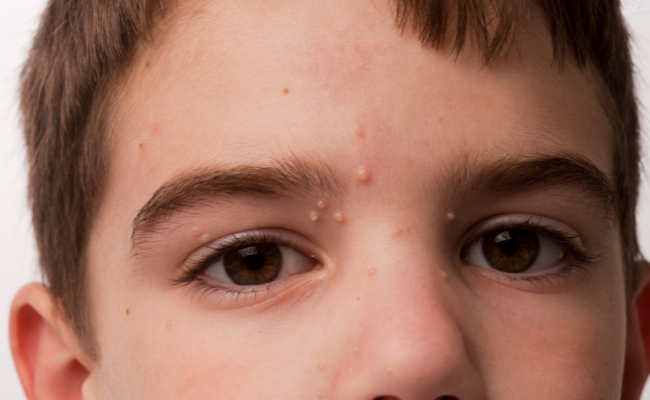How to Treat Molluscum Contagiosum?
- December 18, 2023
- No Comments

What is Molluscum Contagiosum?
Molluscum Contagiosum is a skin infection caused by the Molluscum contagiosum virus (MCV). It results in small, raised bumps resembling pearls on the skin, typically white but possibly matching your natural skin tone or appearing pink to purple. These flesh-colored, dome-shaped bumps often feature a central dimple and can occur on various parts of the body, with a higher prevalence on the face, neck, arms, legs, or genitals.
This contagious condition primarily affects children. Although generally harmless, seeking treatment is common to alleviate discomfort and expedite healing. Understanding the characteristics and treatment options for this viral skin infection is essential for effective care and the overall health of those affected.
Why Does Molluscum Contagiosum Occur?
Molluscum Contagiosum is primarily transmitted through direct skin-to-skin contact or contact with contaminated objects. The virus can enter the skin through minor breaks or hair follicles, making it highly contagious, especially in settings where close contact is common, such as schools and sports activities. The virus can also be spread through sharing towels, toys, or clothing. Although anyone can contract Molluscum Contagiosum, it is more prevalent among children, possibly due to their higher likelihood of close contact with peers.
Individuals with weakened immune systems, such as those with HIV or eczema, may experience more severe and persistent cases of Molluscum Contagiosum. The virus is opportunistic, and compromised immunity can result in prolonged or widespread infections.
How Does Molluscum Contagiosum Present Itself?
The hallmark of Molluscum Contagiosum is the appearance of small, painless bumps on the skin. These bumps can vary in number and size, ranging from a few millimeters to several centimeters in diameter. The characteristic central dimple and the pearly or flesh-colored hue of the lesions make them distinguishable. The incubation period—the time between exposure to the virus and the development of lesions—varies, typically ranging from a few weeks to several months.
The lesions may appear anywhere on the body, excluding the palms of the hands and the soles of the feet. Due to their appearance and the potential for discomfort, individuals often seek medical attention for diagnosis and treatment.
Treatment Solutions for Molluscum Contagiosum
While Molluscum Contagiosum can resolve on its own over time, seeking treatment is a common choice to expedite healing, alleviate symptoms, and prevent further spread. Several treatment approaches are available, and the choice of intervention may depend on factors such as the number of lesions, their location, and the overall health of the individual. Here are some common treatment solutions:
Topical Treatments:
- Prescription Medications: Topical creams or ointments containing medications like imiquimod or tretinoin may be prescribed. These medications work by stimulating the immune system, thereby expediting the resolution of lesions.
- Cantharidin: A solution containing cantharidin can be applied to the lesions by a healthcare professional. This induces the formation of a blister, causing the affected bump to lift off the skin.
Physical Removal:
- Cryotherapy: Cryotherapy involves freezing the lesions with liquid nitrogen. This process causes the lesions to blister and eventually fall off.
- Curettage: Curettage is a procedure where a healthcare provider scrapes off the lesions using a sharp instrument. This is often performed after cryotherapy.
Oral Treatments:
- Cimetidine: In cases of persistent or widespread Molluscum Contagiosum, especially in individuals with compromised immune systems, the oral medication cimetidine may be prescribed.
Home Remedies:
- Apple Cider Vinegar: Some individuals use apple cider vinegar as a home remedy, soaking the affected area with the belief that it may aid in lesion resolution.
- Tea Tree Oil: Applied topically, tea tree oil is thought to possess antiviral properties and may contribute to reducing lesions.
Benefit Points of Treating Molluscum Contagiosum
- Faster Resolution: Treatment interventions can expedite the resolution of Molluscum Contagiosum, reducing the duration of the infection and preventing its spread to others.
- Symptom Relief: Treatment measures alleviate symptoms associated with Molluscum Contagiosum, such as itching and discomfort, improving the overall quality of life for affected individuals.
- Prevention of Spread: Prompt and effective treatment minimizes the risk of transmitting the virus to others, particularly in communal settings like schools and sports activities.
- Reduced Scarring: Certain treatment modalities, such as cryotherapy and curettage, aim to minimize scarring and cosmetic concerns associated with Molluscum Contagiosum.
- Individualized Approach: Healthcare providers tailor treatment plans based on the severity of the infection, the number of lesions, and the individual's overall health, ensuring personalized and effective care.
Comments (0)